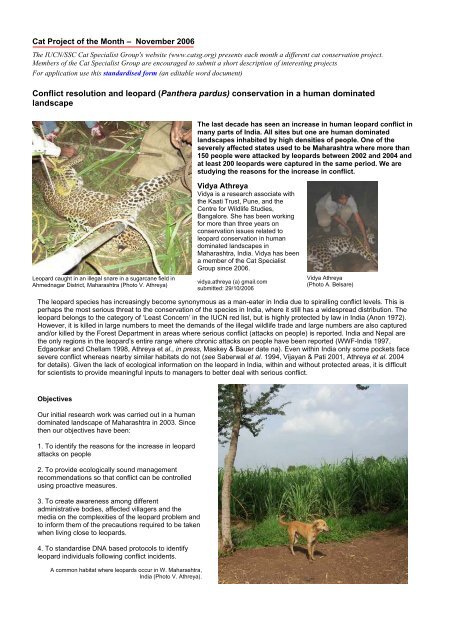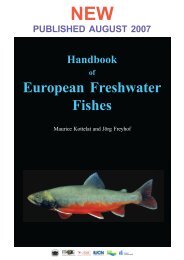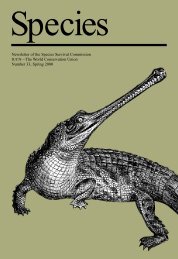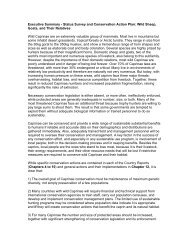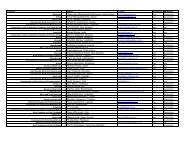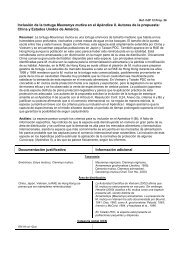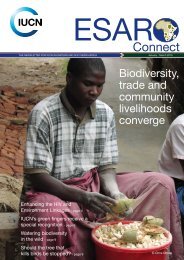Conflict resolution and leopard (Panthera pardus) conservation in a ...
Conflict resolution and leopard (Panthera pardus) conservation in a ...
Conflict resolution and leopard (Panthera pardus) conservation in a ...
Create successful ePaper yourself
Turn your PDF publications into a flip-book with our unique Google optimized e-Paper software.
Cat Project of the Month – November 2006<br />
The IUCN/SSC Cat Specialist Group's website (www.catsg.org) presents each month a different cat <strong>conservation</strong> project.<br />
Members of the Cat Specialist Group are encouraged to submit a short description of <strong>in</strong>terest<strong>in</strong>g projects<br />
For application use this st<strong>and</strong>ardised form (an editable word document)<br />
<strong>Conflict</strong> <strong>resolution</strong> <strong>and</strong> <strong>leopard</strong> (<strong>Panthera</strong> <strong>pardus</strong>) <strong>conservation</strong> <strong>in</strong> a human dom<strong>in</strong>ated<br />
l<strong>and</strong>scape<br />
The last decade has seen an <strong>in</strong>crease <strong>in</strong> human <strong>leopard</strong> conflict <strong>in</strong><br />
many parts of India. All sites but one are human dom<strong>in</strong>ated<br />
l<strong>and</strong>scapes <strong>in</strong>habited by high densities of people. One of the<br />
severely affected states used to be Maharashtra where more than<br />
150 people were attacked by <strong>leopard</strong>s between 2002 <strong>and</strong> 2004 <strong>and</strong><br />
at least 200 <strong>leopard</strong>s were captured <strong>in</strong> the same period. We are<br />
study<strong>in</strong>g the reasons for the <strong>in</strong>crease <strong>in</strong> conflict.<br />
Leopard caught <strong>in</strong> an illegal snare <strong>in</strong> a sugarcane field <strong>in</strong><br />
Ahmednagar District, Maharashtra (Photo V. Athreya)<br />
Vidya Athreya<br />
Vidya is a research associate with<br />
the Kaati Trust, Pune, <strong>and</strong> the<br />
Centre for Wildlife Studies,<br />
Bangalore. She has been work<strong>in</strong>g<br />
for more than three years on<br />
<strong>conservation</strong> issues related to<br />
<strong>leopard</strong> <strong>conservation</strong> <strong>in</strong> human<br />
dom<strong>in</strong>ated l<strong>and</strong>scapes <strong>in</strong><br />
Maharashtra, India. Vidya has been<br />
a member of the Cat Specialist<br />
Group s<strong>in</strong>ce 2006.<br />
vidya.athreya (a) gmail.com<br />
submitted: 29/10/2006<br />
Vidya Athreya<br />
(Photo A. Belsare)<br />
The <strong>leopard</strong> species has <strong>in</strong>creas<strong>in</strong>gly become synonymous as a man-eater <strong>in</strong> India due to spirall<strong>in</strong>g conflict levels. This is<br />
perhaps the most serious threat to the <strong>conservation</strong> of the species <strong>in</strong> India, where it still has a widespread distribution. The<br />
<strong>leopard</strong> belongs to the category of ‘Least Concern’ <strong>in</strong> the IUCN red list, but is highly protected by law <strong>in</strong> India (Anon 1972).<br />
However, it is killed <strong>in</strong> large numbers to meet the dem<strong>and</strong>s of the illegal wildlife trade <strong>and</strong> large numbers are also captured<br />
<strong>and</strong>/or killed by the Forest Department <strong>in</strong> areas where serious conflict (attacks on people) is reported. India <strong>and</strong> Nepal are<br />
the only regions <strong>in</strong> the <strong>leopard</strong>’s entire range where chronic attacks on people have been reported (WWF-India 1997,<br />
Edgaonkar <strong>and</strong> Chellam 1998, Athreya et al., <strong>in</strong> press, Maskey & Bauer date na). Even with<strong>in</strong> India only some pockets face<br />
severe conflict whereas nearby similar habitats do not (see Saberwal et al. 1994, Vijayan & Pati 2001, Athreya et al. 2004<br />
for details). Given the lack of ecological <strong>in</strong>formation on the <strong>leopard</strong> <strong>in</strong> India, with<strong>in</strong> <strong>and</strong> without protected areas, it is difficult<br />
for scientists to provide mean<strong>in</strong>gful <strong>in</strong>puts to managers to better deal with serious conflict.<br />
Objectives<br />
Our <strong>in</strong>itial research work was carried out <strong>in</strong> a human<br />
dom<strong>in</strong>ated l<strong>and</strong>scape of Maharashtra <strong>in</strong> 2003. S<strong>in</strong>ce<br />
then our objectives have been:<br />
1. To identify the reasons for the <strong>in</strong>crease <strong>in</strong> <strong>leopard</strong><br />
attacks on people<br />
2. To provide ecologically sound management<br />
recommendations so that conflict can be controlled<br />
us<strong>in</strong>g proactive measures.<br />
3. To create awareness among different<br />
adm<strong>in</strong>istrative bodies, affected villagers <strong>and</strong> the<br />
media on the complexities of the <strong>leopard</strong> problem <strong>and</strong><br />
to <strong>in</strong>form them of the precautions required to be taken<br />
when liv<strong>in</strong>g close to <strong>leopard</strong>s.<br />
4. To st<strong>and</strong>ardise DNA based protocols to identify<br />
<strong>leopard</strong> <strong>in</strong>dividuals follow<strong>in</strong>g conflict <strong>in</strong>cidents.<br />
A common habitat where <strong>leopard</strong>s occur <strong>in</strong> W. Maharashtra,<br />
India (Photo V. Athreya).
Sites where we carried out human <strong>leopard</strong> conflict related work (research <strong>and</strong><br />
capacity build<strong>in</strong>g of the Forest Department).<br />
Study area<br />
Our work has been carried out <strong>in</strong> the western regions of<br />
Maharashtra. However, our research work has focussed<br />
on Junnar (<strong>in</strong>tensive study was carried out <strong>in</strong> 2003) <strong>and</strong><br />
Nashik Forest Circle (where large number of <strong>leopard</strong>s<br />
are present <strong>in</strong> cropl<strong>and</strong>s). These are human dom<strong>in</strong>ated<br />
l<strong>and</strong>scapes where people live at densities greater than<br />
170 km-2. The Forest Department <strong>in</strong> these areas<br />
manage non-wildlife activities such as plantations, social<br />
forestry etc. Historically Junnar <strong>and</strong> Nashik regions used<br />
to support dry deciduous forests but numerous irrigation<br />
projects <strong>in</strong>itiated a few decades ago have converted the<br />
vegetation to lush cropl<strong>and</strong>s. Cash crops such as<br />
sugarcane, maize, fruit plantations <strong>and</strong> vegetables are<br />
grown. The area faces three dist<strong>in</strong>ct seasons – the<br />
monsoon between June <strong>and</strong> September where daytime<br />
temperature are about 20° C, w<strong>in</strong>ter between October<br />
<strong>and</strong> February where temperatures can decrease to about<br />
7° C <strong>in</strong> the night <strong>and</strong> day time temperatures are about<br />
15° C, the summer where day time temperatures can go<br />
up to 40° C.<br />
Methods<br />
Research project:<br />
1. Carried out <strong>in</strong> 2003, the study used Forest<br />
Department data on conflict <strong>in</strong>cidents, captures <strong>and</strong><br />
releases of <strong>leopard</strong>s, <strong>in</strong>formation from semi-structured<br />
<strong>in</strong>terviews with more than 500 affected people <strong>and</strong> GIS<br />
analysis to track changes <strong>in</strong> vegetation over the last<br />
three decades (Athreya et al. 2004).<br />
2. The management <strong>in</strong> Junnar responded to the large<br />
presence of <strong>leopard</strong>s <strong>in</strong> a human dom<strong>in</strong>ated habitat by<br />
carry<strong>in</strong>g out more than 100 captures <strong>and</strong> translocations<br />
of <strong>leopard</strong>s <strong>in</strong> 2 years. In 2003, we commenced <strong>in</strong>sert<strong>in</strong>g<br />
passive transponders <strong>in</strong>to all <strong>leopard</strong>s trapped <strong>in</strong> the<br />
Junnar Forest Division <strong>and</strong> Nashik Forest Circle for<br />
identify<strong>in</strong>g translocated <strong>leopard</strong>s <strong>in</strong> case of re-capture.<br />
A translocated <strong>leopard</strong>ess captured <strong>in</strong> cropl<strong>and</strong>s <strong>and</strong> released <strong>in</strong>to a<br />
Wildlife Sanctuary attacked a boy the day after her release. The<br />
boy’s father hit her on the head with a sickle. Her identity could be<br />
determ<strong>in</strong>ed by a microchip <strong>in</strong>serted <strong>in</strong> her as part of our project<br />
(Photo K. Mungale).
Capacity build<strong>in</strong>g of the Forest Department:<br />
1. The lack of guidel<strong>in</strong>es available to managers on pre <strong>and</strong> post<br />
capture management of conflict often hampers effective decision<br />
mak<strong>in</strong>g. Currently a management manual is be<strong>in</strong>g made which is<br />
aimed at the managers <strong>in</strong> the state of Maharashtra as well as for<br />
other affected states. This will conta<strong>in</strong> <strong>in</strong>puts from experienced<br />
scientists, managers <strong>and</strong> veter<strong>in</strong>arians <strong>in</strong> India<br />
(http://www.rufford.org/rsg/Projects/VidyaAthreya).<br />
2. The Forest Department field staff often lack appropriate tra<strong>in</strong><strong>in</strong>g<br />
or facilities to h<strong>and</strong>le <strong>leopard</strong>s <strong>and</strong> <strong>leopard</strong> emergencies <strong>in</strong> conflict<br />
areas. Tra<strong>in</strong><strong>in</strong>g <strong>and</strong> awareness programmes were held for the<br />
Forest Department personnel, Police Department, Fire Brigade<br />
<strong>and</strong> NGO members <strong>in</strong> the most affected areas of W. Maharashtra<br />
so that the species <strong>and</strong> the situation could be better dealt with <strong>in</strong><br />
case of emergencies. This exercise also created a rapport with the<br />
local Forest Department officials <strong>and</strong> allowed us to obta<strong>in</strong> a better<br />
underst<strong>and</strong><strong>in</strong>g of the conflict at the field level. This was carried out<br />
<strong>in</strong> collaboration with Dr Belsare, a wildlife veter<strong>in</strong>arian who s<strong>in</strong>ce<br />
then has also extended this programme to other affected states<br />
(http://www.rufford.org/rsg/Projects/AniruddhaVBelsare). These<br />
sensitization <strong>and</strong> tra<strong>in</strong><strong>in</strong>g workshops are held whenever the need<br />
arises.<br />
Tra<strong>in</strong><strong>in</strong>g Forest Department staff to rescue <strong>leopard</strong>s found <strong>in</strong><br />
emergency situations (Photo G. Mallapur/V. Hosh<strong>in</strong>g).<br />
Education of local people<br />
Local people are educated about the complexities of the <strong>leopard</strong> conflict <strong>and</strong> provided with a list of precautionary measures that<br />
need to be taken <strong>in</strong> areas where <strong>leopard</strong>s are present. We are also carry<strong>in</strong>g out awareness meet<strong>in</strong>gs for the rural media so that<br />
the sensational report<strong>in</strong>g is controlled.<br />
1. The results of our Junnar project <strong>in</strong>dicated that the surge <strong>in</strong> conflict was related to the translocation of more than 30 <strong>leopard</strong>s<br />
<strong>in</strong>to adjo<strong>in</strong><strong>in</strong>g forested areas (see Athreya et al. 2004 for details). Furthermore, analysis of similar conflict from other areas (W.<br />
Bengal, two sites <strong>in</strong> Gujarat, all sites <strong>in</strong> Maharashtra) <strong>in</strong>dicated that all the human dom<strong>in</strong>ated sites report<strong>in</strong>g <strong>leopard</strong>s were<br />
adjo<strong>in</strong><strong>in</strong>g forested areas where <strong>leopard</strong>s trapped elsewhere were rout<strong>in</strong>ely translocated <strong>in</strong>to (Athreya et al. In Press).<br />
2. Our work <strong>in</strong> the Nashik Forest Circle shows that <strong>leopard</strong>s<br />
can live among high densities of people, <strong>in</strong> human<br />
dom<strong>in</strong>ated areas, with low levels of conflict. N<strong>in</strong>eteen<br />
<strong>leopard</strong>s were removed from the Ahmednagar Forest<br />
DIvison over the last 18 months (microchipped by us) <strong>and</strong><br />
prior to their capture no attacks on people were reported.<br />
These animals are at least two – three years old. When<br />
viewed <strong>in</strong> light of the work <strong>in</strong> Junnar where large scale<br />
releases <strong>and</strong> translocations <strong>in</strong>to adjo<strong>in</strong><strong>in</strong>g forests<br />
exacerbated conflict levels, it is very important that<br />
management takes a more proactive st<strong>and</strong> to ensure low<br />
levels of attacks, <strong>in</strong> areas where <strong>leopard</strong>s live amongst high<br />
densities of people.<br />
3. Awareness was seen to be a very powerful tool at all<br />
levels – senior managers to the field staff of the Forest<br />
Department, the affected villagers, NGO’s <strong>and</strong> Police<br />
Department personnel.<br />
Meet<strong>in</strong>g with the village adm<strong>in</strong>istration <strong>and</strong> villagers where human<br />
attacks by <strong>leopard</strong>s have taken place (Photo B. P<strong>and</strong>harkar).
Next Steps: 1. It is likely that many <strong>in</strong>nocent <strong>leopard</strong>s are trapped follow<strong>in</strong>g a conflict <strong>in</strong>cident due to the lack of procedures to<br />
identify <strong>in</strong>dividual <strong>leopard</strong>s. We are currently <strong>in</strong> the process of st<strong>and</strong>ardis<strong>in</strong>g techniques required for identify<strong>in</strong>g <strong>in</strong>dividual<br />
<strong>leopard</strong>s us<strong>in</strong>g genetic material.<br />
2. Most of the high human <strong>leopard</strong> conflict sites <strong>in</strong> India are <strong>in</strong> human dom<strong>in</strong>ated l<strong>and</strong>scapes. Information on the <strong>leopard</strong><br />
densities present <strong>in</strong> such areas <strong>and</strong> their ma<strong>in</strong> prey is necessary to provide recommendations to managers on how to make<br />
such sites less attractive to potentially dangerous carnivores like the <strong>leopard</strong>s. The proposed study is await<strong>in</strong>g fund<strong>in</strong>g.<br />
Project Information<br />
Duration: 2003-<br />
Location (see map):<br />
Partners<br />
Sponsor(s):<br />
Project address:<br />
Project leader:<br />
Maharashtra<br />
Maharashtra State Forest Department<br />
The Rufford Maurice La<strong>in</strong>g Foundation, U.K.<br />
Wildlife Conservation Society – India Program<br />
Wildlife Trust of India, New Delhi<br />
Wildlife Protection Society of India, New Delhi<br />
Kaati Trust, D-3, Raanwara, Bavdhan. Pune 411021. Maharashtra. India<br />
Vidya Athreya, Research Associate, Kaati Trust, Pune<br />
Research Associate, Centre for Wildlife Studies, Bangalore<br />
vidya.athreya@gmail.com<br />
Project website:


